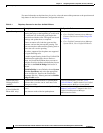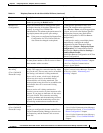
5-3
Cisco Unified IP Phone 6901 and 6911 Administration Guide for Cisco Unified Communications Manager 8.5 (SCCP and SIP)
OL-23874-01
Chapter 5 Configuring Features, Templates, Services, and Users
Telephony Features Available for the Cisco Unified IP Phone
Automatic Port
Synchronization
(Cisco Unified IP
Phone 6911 only)
When the Cisco Unified CM administrator uses the
Remote Port Configuration feature to set the speed
and duplex function of an IP phone remotely, loss
of packets can occur if one port is slower than the
other.
The Automatic Port Synchronization feature
synchronizes the ports to the lowest speed among
the two ports, which eliminates packet loss. When
automatic port synchronization is enabled, it is
recommended that both ports be configured for
autonegotiate. If one port is enabled for
autonegotiate and the other is at a fixed speed, the
phone synchronizes to the fixed port speed.
Note If both the ports are configured for fixed
speed, the Automatic Port Synchronization
feature is ineffective.
The Remote Port Configuration and
Automatic Port Synchronization features
are compatible only with IEEE 802.3AF
Power of Ethernet (PoE) switches.
Switches that support only Cisco Inline
Power are not compatible. Enabling this
feature on phones that are connected to
these types of switches could result in loss
of connectivity to Cisco Unified CM, if the
phone is powered by PoE.
To configure the parameter in the Cisco
Unified CM Administration application,
choose Device > Phone, select the appropriate
IP phones, and scroll to the Product Specific
Configuration Layout
pane.
To configure the setting on multiple phones
simultaneously, enable Automatic Port
Synchronization in either the Enterprise Phone
Configuration (System > Enterprise Phone
Configuration) or the Common Phone Profile
Configuration (Device > Device Settings >
Common Phone Profile).
Auto Barge Allows user to cbarge into a shared line call
automatically.
For more information, refer to:
• Cisco Unified Communications Manager
Features and Services Guide “
Barge and
Privacy” chapter.
Block External to
External Transfer
Prevents users from transferring an external call to
another external number.
For more information, go to the “External Call
Transfer Restrictions” chapter in the Cisco
Unified Communications Manager Features
and Services Guide.
Call Forward Allows users to redirect incoming calls to another
number. Call forward options include Call Forward
All, Call Forward Busy, Call Forward No Answer,
and Call Forward No Coverage.
You will hear a stutter tone after off-hook if Call
Forward All feature is configured on your phone.
For more information, refer to:
• Cisco Unified Communications Manager
Administration Guide, “
Directory
Number Configuration” chapter.
• Cisco Unified Communications Manager
System Guide, “
Cisco Unified IP Phone”
chapter.
• “Specifying Options that Appear on the
User Options Web Pages” section on
page 5-11
Table 5-1 Telephony Features for the Cisco Unified IP Phone (continued)
Feature Description Configuration Reference


















